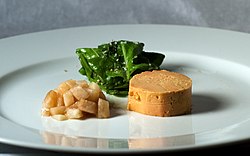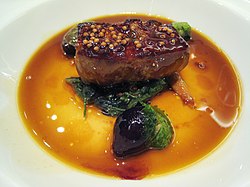 Foie gras (pronounced /fwɑːˈgrɑː/ in English; French for "fat liver") is a food product made of the liver of a duck or goose that has been specially fattened. This fattening is typically achieved through gavage (force-feeding), according to French law[1], though outside of France, high quality product has also been produced using natural voluntary feeding. Pâté de foie gras was formerly known as "Strassburg pie" in English due to that city being a major producer of this food product[2].
Foie gras (pronounced /fwɑːˈgrɑː/ in English; French for "fat liver") is a food product made of the liver of a duck or goose that has been specially fattened. This fattening is typically achieved through gavage (force-feeding), according to French law[1], though outside of France, high quality product has also been produced using natural voluntary feeding. Pâté de foie gras was formerly known as "Strassburg pie" in English due to that city being a major producer of this food product[2].
Foie gras is one of the most popular and well-known delicacies in French cuisine and its flavour is described as rich, buttery, and delicate, unlike that of a regular duck or goose liver. Foie gras can be sold whole, or prepared into mousse, parfait, or pâté (the lowest quality), and is typically served as an accompaniment to another food item, such as toast or steak.
The technique of gavage dates as far back as 2500 BC, when the ancient Egyptians began keeping birds for food and deliberately fattened the birds through force-feeding.[3] Today, France is by far the largest producer and consumer of foie gras, though it is produced and consumed worldwide, particularly in other European nations, the United States, and China.[4]
Gavage-based foie gras production is controversial, due to the force feeding procedure, and the possible health consequences of an enlarged liver, and a number of countries and other jurisdictions have laws against force feeding or the sale of foie gras due to how it is traditionally produced.


No comments:
Post a Comment